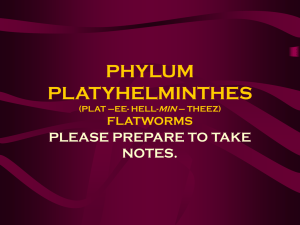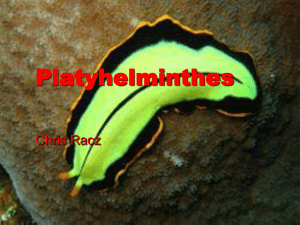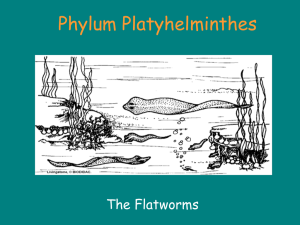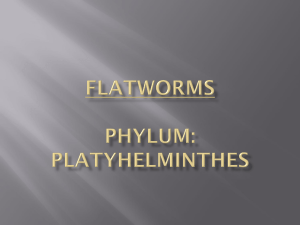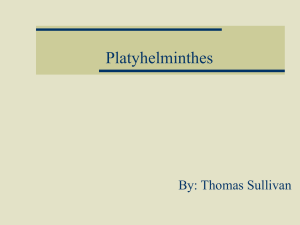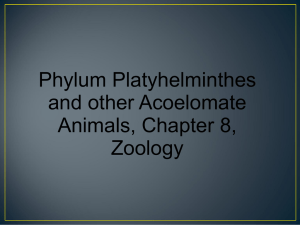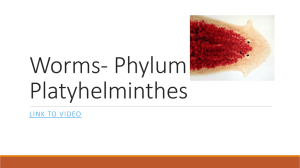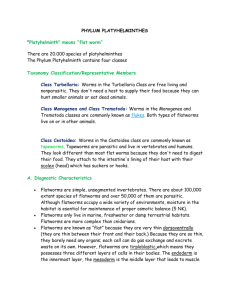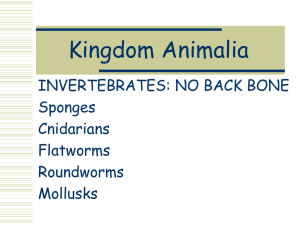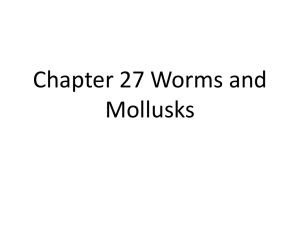Flatworms Phylum: PLATYHELMINTHES
advertisement
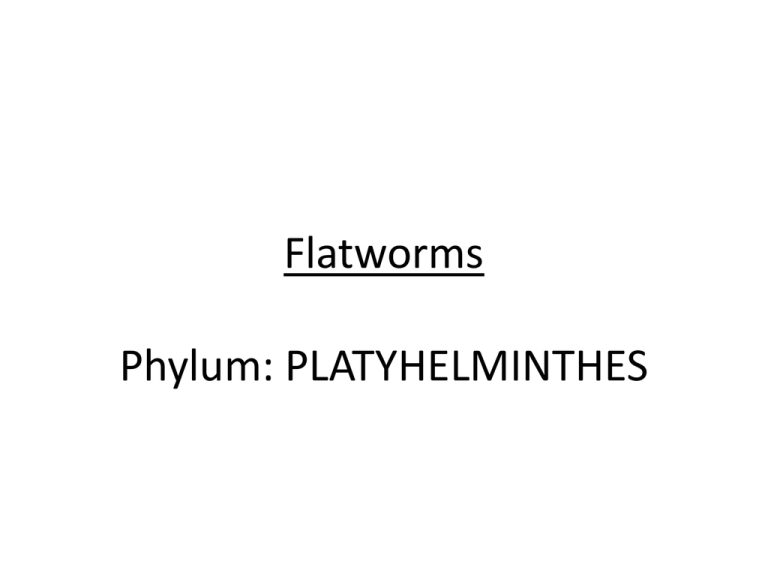
Flatworms Phylum: PLATYHELMINTHES VS. Class Turbellaria includes: Planarians Class Cestoda Includes: Tapeworms Class Trematoda Includes: Flukes II. Body Plan/Structure • Flatworms demonstrate a bilaterally symmetrical body plan • They are dorsoventrally flattened and lack a skeleton II. Body Plan/Structure con’t • They have a highly branched gastrovascular cavity . • There is only one opening which serves the function of both the mouth and anus • They have three germ layers: – Ectoderm: Outside – Endoderm: Inside – Mesoderm: Middle layer of tissue between the ectoderm and the endoderm • Though Flatworms have three germ layers they are acoelomates and have no body cavity • Flatworms do have true organs and primitive organ systems that are used for digestion and excretion • Flatworms are also the most primitive organisms to show cephalization. • The head region of Flatworms contains a concentration of nerve tissue called ganglia (singular=ganglion) that resembles a primitive brain. Cephalization • They have two nerve cords that run from the ganglia in the head region along the ventral side of the worm to the tale region • In the head region of Flatworms are two eyespots • They also have lobes on the side of their head called auricles Auricles Feeding • Flatworms have a mouth/anus which is connected to the gastrovascular system through a long muscular pharynx. • Small invertebrates or the remains of dead animals are taken into the mouth/anus by the muscular pharynx • The food is then digested in the highly branched gastrovascular cavity • The nutrients moves from the gut into the body cells by diffusion Respiration • Respiration occurs by diffusion Internal Transport • Nutrients and oxygen in the gut are simply absorbed into the body cells by the process of diffusion Excretion • Most undigested food is released directly out of the anus/mouth: Pharynx Nerve Response • Flatworms are able to sense and respond to at least three forms of stimuli: – Sense and respond to light: The eye-spots can detect light and allow the Flatworms to respond to it – Sense and respond to chemicals: Pits on the side of their head regions can sense chemicals in the water and allow the Flatworms to respond (like “smelling”) – Sense and respond to touch: The auricles on either side of the head region can sense touch and allow the Flatworms to respond • The ganglia in the head region relay messages from the sensory organs down the nerve cords to the rest of the body. The nerve cords can control muscles in the body which allow the Flatworms to move or eat. Auricles Movement • The flatworms move across a surface using cilia on their ventral surface • They can also move by contracting circular and longitudinal muscles that lay just below the ectoderm. These muscles are controlled by the nerve cords. Reproduction • Asexual Reproduction: – Flatworms can asexually reproduce through a process called fission. The anterior and posterior ends hold a surface and the midsection constricts. This results in two new flatworms, one from the anterior end of the original flatworm and the other from the posterior end of the original flatworm. Reproduction • Flatworms can also regenerate parts they have lost. • Sexual Reproduction: – Flatworms are hermaphroditic – After two flatworms have copulated they release sacs of fertilized eggs and attach them to a surface Parasitic Flatworms: Tapeworms • The tapeworm has an anterior end called a scolex with complicated hooks for attaching to the intestines of its host. • The tapeworm does not have a mouth or digestive system. Instead they bath in the predigested fluids of their host and absorb nutrients directly into their body cells Hooks Scolex Suckers Proglottids Lifecycle of a Tapeworm
